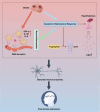Association between cardiometabolic index and depression in a stroke population: a cross-sectional study of NHANES
- PMID: 39966981
- PMCID: PMC11834320
- DOI: 10.1186/s40001-025-02363-3
Association between cardiometabolic index and depression in a stroke population: a cross-sectional study of NHANES
Abstract
Background: Stroke is a prevalent neurological disorder globally, often resulting in post-stroke depression (PSD). The cardiometabolic index (CMI) is a novel marker for assessing cardiovascular and metabolic health, but its association with PSD has not been adequately investigated. This study aims to explore the relationship between CMI and PSD, providing a basis for clinical prevention and treatment.
Methods: We utilized data from the 2007-2018 National Health and Nutrition Examination Survey (NHANES) in this cross-sectional analysis. Multivariable logistic regression and restricted cubic spline (RCS) models were applied to assess the independent and linear relationships between CMI and PSD. To minimize confounding, propensity score matching (PSM) was employed. Subgroup analyses and interaction tests were also conducted to further explore potential effect modifications.
Results: A total of 1082 participants were included, with 18.67% diagnosed with PSD. Higher CMI levels were positively associated with PSD in stroke patients. In the fully adjusted model, the association between CMI and PSD remained significant (OR = 1.06; 95% CI 1.01-1.12). RCS analysis indicated a linear relationship between CMI and PSD (nonlinearity P = 0.334). Subgroup analyses showed that this association persisted across different groups (all P for trend > 0.05). After covariate balance through PSM, the positive association between CMI and PSD was further supported.
Conclusion: This study demonstrates a positive association between CMI and PSD. CMI may serve as a useful tool for evaluating the risk of depressive symptom in stroke patients, potentially aiding in targeted clinical interventions.
Keywords: Cardiometabolic index (CMI); Cross-sectional study; Depressive symptom; NHANES; Stroke.
© 2025. The Author(s).
Conflict of interest statement
Declarations. Ethics approval and consent to participate: Not applicable. Consent for publication: Not applicable. Competing interests: The authors declare no competing interests.
Figures
References
-
- Ignacio KHD, Muir RT, Diestro JDB, Singh N, Yu MHLL, Omari OE, et al. Prevalence of depression and anxiety symptoms after stroke in young adults: a systematic review and meta-analysis. J Stroke Cerebrovasc Dis. 2024;33. https://www.strokejournal.org/article/S1052-3057(24)00177-0/fulltext. Accessed 2 July 2024. - PubMed
-
- Towfighi A, Ovbiagele B, El Husseini N, Hackett ML, Jorge RE, Kissela BM, et al. Poststroke depression: a scientific statement for healthcare professionals from the American Heart Association/American Stroke Association. Stroke. 2017;48:e30-43. - PubMed
-
- Sivertsen H, Bjørkløf GH, Engedal K, Selbæk G, Helvik A-S. Depression and quality of life in older persons: a review. Dement Geriatr Cogn Disord. 2015;40:311–39. - PubMed
MeSH terms
LinkOut - more resources
Full Text Sources
Medical
Miscellaneous





